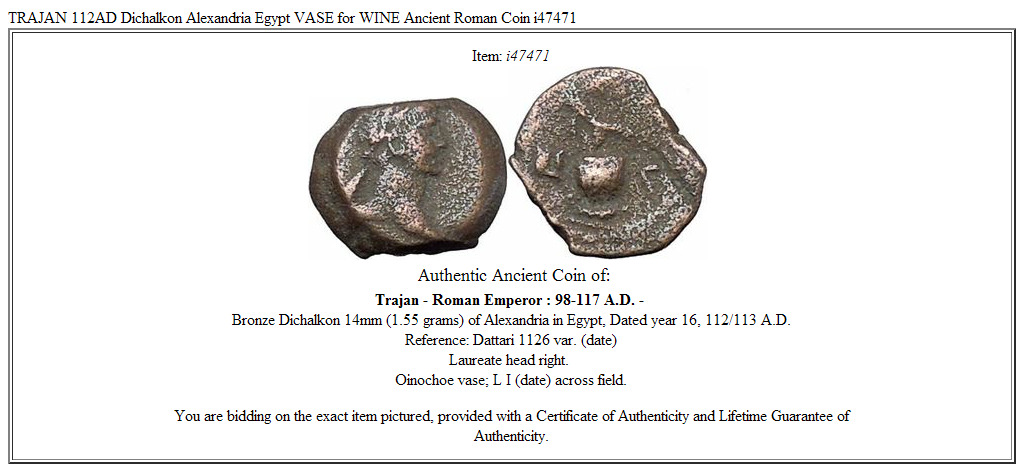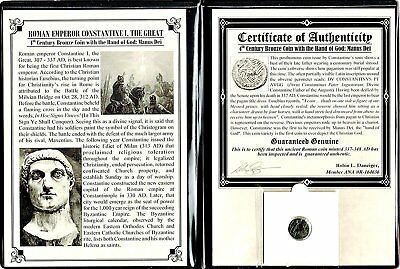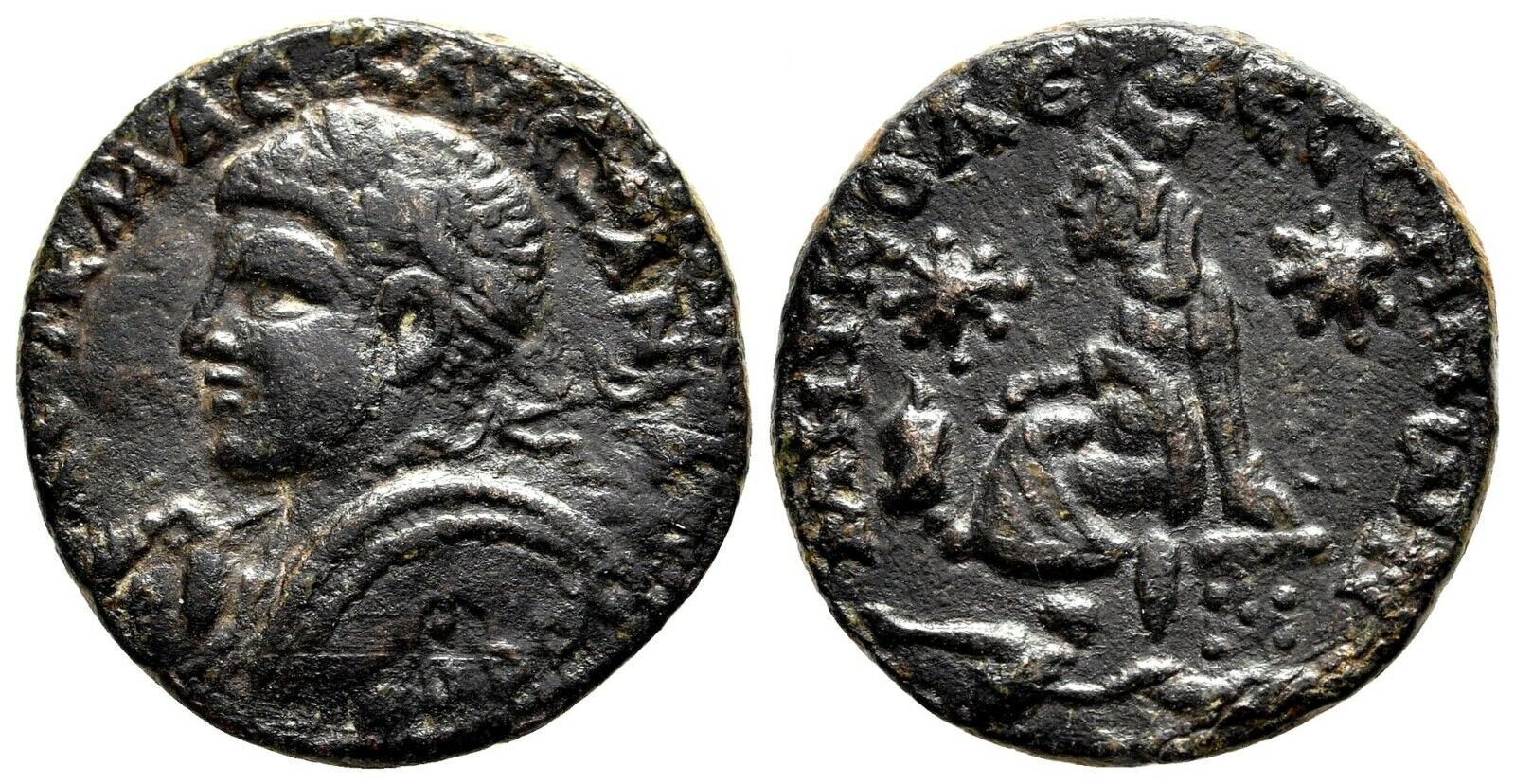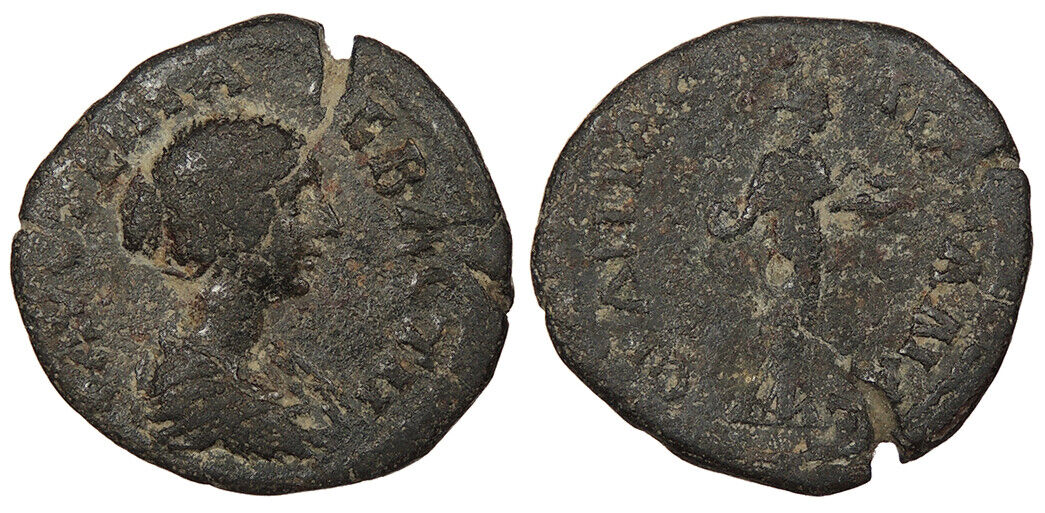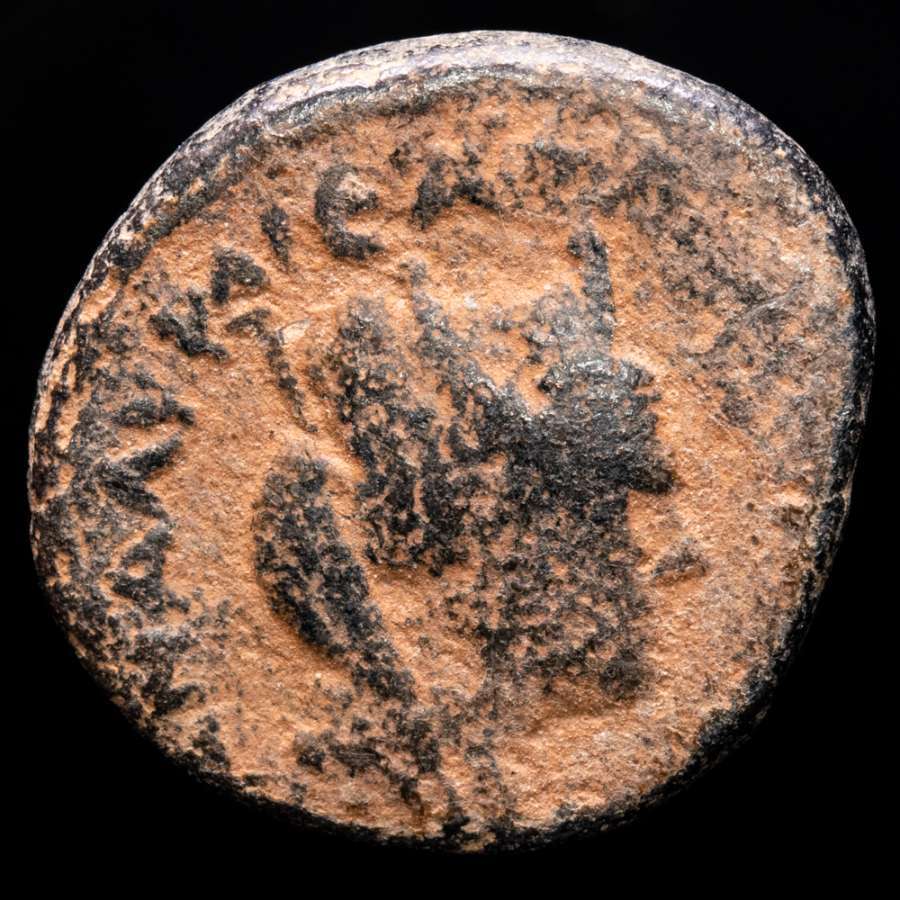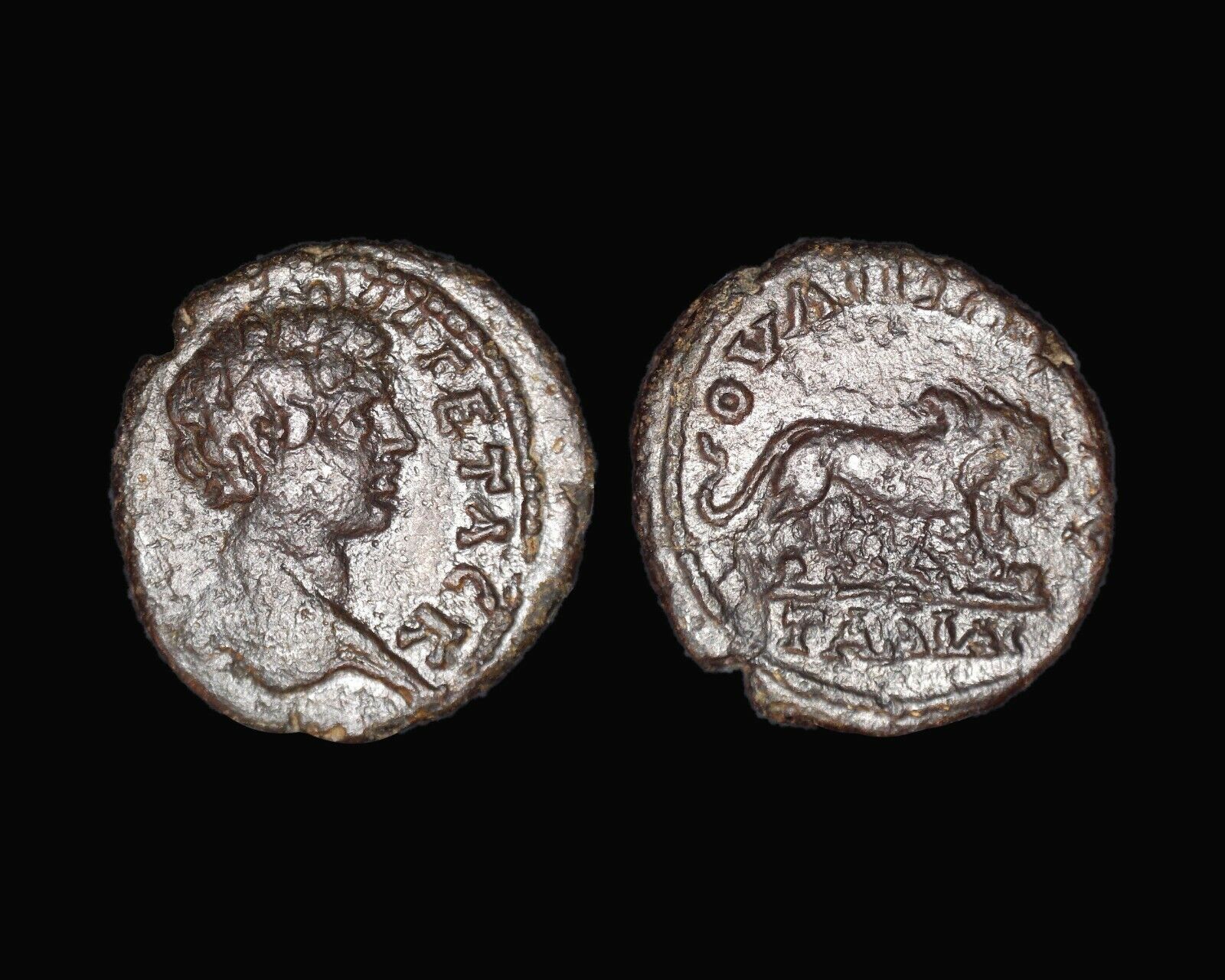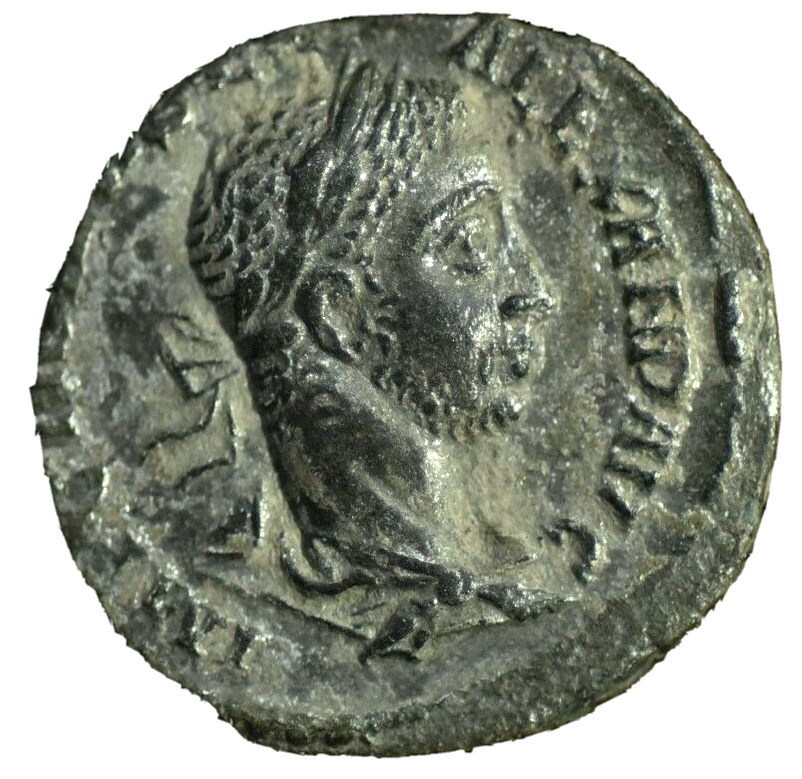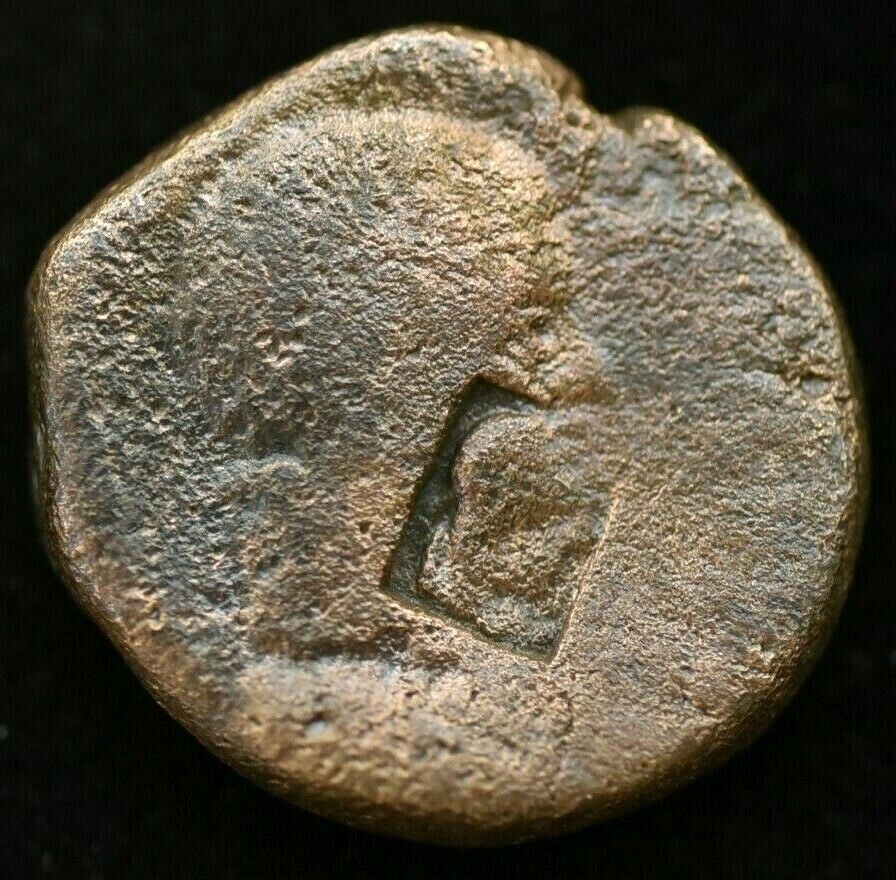-40%
TRAJAN 112AD Dichalkon Alexandria Egypt VASE for WINE Ancient Roman Coin i47471
$ 116.16
- Description
- Size Guide
Description
Item:i47471
Authentic Ancient Coin of:
Trajan
-
Roman Emperor
: 98-117 A.D. -
Bronze Dichalkon 14mm (1.55 grams) of
Alexandria
in Egypt, Dated year 16, 112/113 A.D.
Reference: Dattari 1126 var. (date)
Laureate head right.
Oinochoe vase; L I ς (date) across field.
You are bidding on the exact item pictured, provided with a Certificate of Authenticity and Lifetime Guarantee of Authenticity.
An
oenochoe
, also spelled
oinochoe
(
Ancient Greek
:
οἰνοχόη
; from Ancient Greek: οἶνος
oinos
, "wine" and χέω
kheō
, "to pour") is a
wine
jug
and a key form of
Greek pottery
. There are many different forms of oenochoe. The earliest is the
olpe
(ὀλπή) and has an S-shaped profile from head to foot.
Oenochoai may be decorated or undecorated. Oenochoai typically have only one handle at the back and may include a
trefoil
pouring spout.
The Greek oenochoe was normally of painted
terracotta
pottery but metal oenochoai are also found.
See also
Corpus vasorum antiquorum
Alexandria was founded by
Alexander the Great
in April 331 BC as
Ἀλεξάνδρεια
(
Alexándreia
). Alexander's
chief architect
for the project was
Dinocrates
. Alexandria was intended to supersede
Naucratis
as a
Hellenistic
center in Egypt, and to be the link between Greece and the rich
Nile Valley
. An Egyptian city,
Rhakotis
, already existed on the shore, and later gave its name to Alexandria in the
Egyptian language
(Egyptian
*Raˁ-Ḳāṭit
, written
rˁ-ḳṭy.t
, 'That which is built up'). It continued to exist as the Egyptian quarter of the city. A few months after the foundation, Alexander left Egypt and never returned to his city. After Alexander's departure, his viceroy,
Cleomenes
, continued the expansion. Following a struggle with the other successors of Alexander, his general
Ptolemy
succeeded in bringing Alexander's body to Alexandria.
Alexandria, sphinx made of
pink granite
,
Ptolemaic
.
Although Cleomenes was mainly in charge of overseeing Alexandria's continuous development, the
Heptastadion
and the mainland quarters seem to have been primarily Ptolemaic work. Inheriting the trade of ruined
Tyre
and becoming the centre of the new commerce between Europe and the
Arabian
and Indian East, the city grew in less than a generation to be larger than
Carthage
. In a century, Alexandria had become the largest city in the world and, for some centuries more, was second only to Rome. It became Egypt's main Greek city, with
Greek people
from diverse backgrounds.
Alexandria was not only a centre of
Hellenism
, but was also home to the largest Jewish community in the world. The
Septuagint
, a Greek translation of the
Hebrew Bible
, was produced there. The early Ptolemies kept it in order and fostered the development of its museum into the leading Hellenistic center of learning (
Library of Alexandria
), but were careful to maintain the distinction of its population's three largest ethnicities: Greek, Jewish, and
Egyptian
. From this division arose much of the later turbulence, which began to manifest itself under
Ptolemy Philopater
who reigned from 221–204 BC. The reign of
Ptolemy VIII Physcon
from 144–116 BC was marked by purges and civil warfare.
The city passed formally under Roman jurisdiction in 80 BC, according to the will of
Ptolemy Alexander
, but only after it had been under Roman influence for more than a hundred years. It was captured by
Julius Caesar
in 47 BC during a Roman intervention in the domestic civil war between king
Ptolemy XIII
and his advisers, and the fabled queen
Cleopatra VII
. It was finally captured by
Octavian
, future
emperor
Augustus on 1 August 30 BC, with the name of the month later being changed to
August
to commemorate his victory.
In AD 115, large parts of Alexandria were destroyed during the
Kitos War
, which gave
Hadrian
and his architect,
Decriannus
, an opportunity to rebuild it. In 215, the
emperor
Caracalla
visited the city and, because of some insulting
satires
that the inhabitants had directed at him, abruptly commanded his troops to
put to death
all youths capable of bearing arms. On 21 July 365, Alexandria was devastated by a
tsunami
(
365 Crete earthquake
), an event still annually commemorated 17 hundred years later as a "day of horror." In the late 4th century, persecution of
pagans
by newly Christian Romans had reached new levels of intensity. In 391, the Patriarch
Theophilus
destroyed all pagan temples in Alexandria under orders from Emperor
Theodosius I
. The
Brucheum
and Jewish quarters were desolate in the 5th century. On the mainland, life seemed to have centred in the vicinity of the
Serapeum
and
Caesareum
, both of which became
Christian churches
. The
Pharos
and
Heptastadium
quarters, however, remained populous and were left intact.
In 619, Alexandria
fell
to the
Sassanid Persians
. Although the
Byzantine Emperor
Heraclius
recovered it in 629, in 641 the Arabs under the general
Amr ibn al-As
captured it during the
Muslim conquest of Egypt
, after a siege that lasted 14 months.
Marcus Ulpius Nerva Traianus
, commonly known as
Trajan
(18 September, 53 – 8 August, 117), was a
Roman Emperor
who reigned from AD 98 until his death in AD 117. Born
Marcus Ulpius Traianus
into a non-
patrician
family in the
Hispania Baetica
province (modern day
Spain
), Trajan rose to prominence during the reign of emperor
Domitian
, serving as a general in the
Roman army
along the
German frontier
, and successfully crushing the revolt of
Antonius Saturninus
in 89. On September 18, 96, Domitian was succeeded by
Marcus Cocceius Nerva
, an old and childless senator who proved to be unpopular with the army. After a brief and tumultuous year in power, a revolt by members of the
Praetorian Guard
compelled him to adopt the more popular Trajan as his heir and successor. Nerva died on January 27, 98, and was succeeded by his adopted son without incident.
As a civilian administrator, Trajan is best known for his extensive public building program, which reshaped the city of
Rome
and left multiple enduring landmarks such as
Trajan's Forum
,
Trajan's Market
and
Trajan's Column
. It was as a military commander however that Trajan celebrated his greatest
triumphs
. In 101, he launched a
punitive expedition
into the kingdom of
Dacia
against king
Decebalus
, defeating the Dacian army near
Tapae
in 102, and finally conquering Dacia completely in 106. In 107, Trajan pushed further east and annexed the
Nabataean kingdom
, establishing the province of
Arabia Petraea
. After a period of relative peace within the Empire, he launched his final campaign in 113 against
Parthia
, advancing as far as the city of
Susa
in 116, and expanding the Roman Empire to its greatest extent. During this campaign Trajan was struck by illness, and late in 117, while sailing back to Rome, he died of a
stroke
on
August 9
, in the city of
Selinus
. He was
deified
by the Senate and his ashes were laid to rest under
Trajan's Column
. He was succeeded by his adopted son (not having a biological heir)
Publius Aelius Hadrianus
—commonly known as Hadrian.
As an emperor, Trajan's reputation has endured - he is one of the few rulers whose reputation has survived the scrutiny of nineteen centuries of history. Every new emperor after him was honoured by the Senate with the prayer
felicior Augusto, melior Traiano
, meaning "may he be luckier than
Augustus
and better than Trajan". Among
medieval
Christian theologians, Trajan was considered a
virtuous pagan
, while the 18th century historian
Edward Gibbon
popularized the notion of the
Five Good Emperors
, of which Trajan was the second.
Early life and rise to power
Trajan was born on September 18, 53 in the Roman province of
Hispania Baetica
(in what is now
Andalusia
in modern Spain), a province that was thoroughly Romanized and called southern Hispania, in the city of
Italica
, where the
Italian
families were paramount. Of
Italian
stock himself, Trajan is frequently but misleadingly designated the first provincial emperor.
Trajan was the son of
Marcia
and
Marcus Ulpius Traianus
, a prominent
senator
and general from the famous
Ulpia
gens
. Trajan himself was just one of many well-known Ulpii in a line that continued long after his own death. His elder sister was
Ulpia Marciana
and his niece was
Salonina Matidia
. The
patria
of the Ulpii was
Italica
, in Spanish Baetica, where their ancestors had settled late in the third century B.C. This indicates that the Italian origin was paramount, yet it has recently been cogently argued that the family's ancestry was local, with Trajan senior actually a Traius who was adopted into the family of the Ulpii.
As a young man, he rose through the ranks of the
Roman army
, serving in some of the most contentious parts of the Empire's frontier. In 76–77, Trajan's father was
Governor
of
Syria
(
Legatus
pro praetore Syriae
), where Trajan himself remained as
Tribunus
legionis
. Trajan was nominated as
Consul
and brought
Apollodorus of Damascus
with him to
Rome
around 91. Along the
Rhine River
, he took part in the Emperor
Domitian
's wars while under Domitian's successor,
Nerva
, who was unpopular with the army and needed to do something to gain their support. He accomplished this by naming Trajan as his adoptive son and successor in the summer of 97. According to the
Augustan History
, it was the future Emperor
Hadrian
who brought word to Trajan of his adoption. When Nerva died on January 27, 98, the highly respected Trajan succeeded without incident.
His reign
The new Roman emperor was greeted by the people of Rome with great enthusiasm, which he justified by governing well and without the bloodiness that had marked Domitian's reign. He freed many people who had been unjustly imprisoned by Domitian and returned a great deal of private property that Domitian had confiscated; a process begun by Nerva before his death. His popularity was such that the
Roman Senate
eventually bestowed upon Trajan the
honorific
of
optimus
, meaning "the best".
Dio Cassius
, sometimes known as Dio, reveals that Trajan drank heartily and was
involved with boys
. "I know, of course, that he was devoted to boys and to wine, but if he had ever committed or endured any base or wicked deed as the result of this, he would have incurred censure; as it was, however, he drank all the wine he wanted, yet remained sober, and in his relation with boys he harmed no one." This sensibility was one that influenced his governing on at least one occasion, leading him to favour the king of Edessa out of appreciation for his handsome son: "On this occasion, however,
Abgarus
, induced partly by the persuasions of his son Arbandes, who was handsome and in the pride of youth and therefore in favour with Trajan, and partly by his fear of the latter's presence, he met him on the road, made his apologies and obtained pardon, for he had a powerful intercessor in the boy."
Dacian Wars
It was as a military commander that Trajan is best known to history, particularly for his conquests in the
Near East
, but initially for the two wars against
Dacia
— the reduction to client kingdom (101-102), followed by actual incorporation to the Empire of the trans-Danube border kingdom of Dacia—an area that had troubled Roman thought for over a decade with the unfavourable (and to some, shameful) peace negotiated by
Domitian
's ministers In the first war c. March–May 101, he launched a vicious attack into the kingdom of
Dacia
with four legions, crossing to the northern bank of the
Danube River
on a stone bridge he had built, and defeating the Dacian army near or in a
mountain pass
called
Tapae
(see
Second Battle of Tapae
). Trajan's troops were mauled in the encounter, however and he put off further campaigning for the year to heal troops, reinforce, and regroup.
Trajan's Column
.
During the following winter, King
Decebalus
launched a counter-attack across the
Danube
further downstream, but this was repulsed. Trajan's army advanced further into Dacian territory and forced King Decebalus to submit to him a year later, after Trajan took the Dacian capital/fortress of
Sarmizegethusa
. The Emperor Domitian had campaigned against
Dacia from 86 to 87
without securing a decisive outcome, and Decebalus had brazenly flouted the terms of the peace (89 AD) which had been agreed on conclusion of this campaign.
Trajan now returned to Rome in triumph and was granted the title
Dacicus Maximus
. The victory was celebrated by the
Tropaeum Traiani
. Decebalus though, after being left to his own devices, in 105 undertook an invasion against Roman territory by attempting to stir up some of the tribes north of the river against her.
Trajan took to the field again and after building with the design of
Apollodorus of Damascus
his
massive bridge over the Danube
, he conquered Dacia completely in 106. Sarmizegethusa was destroyed,
Decebalus
committed
suicide
, and his severed head was exhibited in Rome on the steps leading up to the
Capitol
. Trajan built a new city, "Colonia Ulpia Traiana Augusta Dacica Sarmizegetusa", on another site than the previous Dacian Capital, although bearing the same full name, Sarmizegetusa. He resettled Dacia with Romans and annexed it as a province of the Roman Empire. Trajan's Dacian campaigns benefited the Empire's finances through the acquisition of Dacia's gold mines. The victory is celebrated by
Trajan's Column
.
Expansion in the East
At about the same time
Rabbel II Soter
, one of Rome's client kings, died. This event might have prompted the annexation of the
Nabataean kingdom
, although the manner and the formal reasons for the annexation are unclear. Some epigraphic evidence suggests a military operation, with forces from
Syria
and
Egypt
. What is clear, however, is that by 107, Roman legions were stationed in the area around
Petra
and
Bostra
, as is shown by a papyrus found in Egypt. The empire gained what became the province of
Arabia Petraea
(modern southern
Jordan
and north west
Saudi Arabia
).
Period of peace
The next seven years, Trajan ruled as a civilian emperor, to the same acclaim as before. It was during this time that he corresponded with
Pliny the Younger
on the subject of how to deal with the
Christians
of
Pontus
, telling Pliny to leave them alone unless they were openly practicing the religion. He built several new buildings, monuments and roads in
Italia
and his native
Hispania
. His magnificent complex in Rome raised to commemorate his victories in
Dacia
(and largely financed from that campaign's loot)—consisting of a
forum
,
Trajan's Column
, and Trajan's Market still stands in Rome today. He was also
a prolific builder of triumphal arches
, many of which survive, and rebuilder of roads (
Via Traiana
and
Via Traiana Nova
).
One notable act of Trajan was the hosting of a three-month
gladiatorial
festival in the great
Colosseum
in Rome (the precise date of this festival is unknown). Combining chariot racing, beast fights and close-quarters gladiatorial bloodshed, this gory spectacle reputedly left 11,000 dead (mostly slaves and criminals, not to mention the thousands of ferocious beasts killed alongside them) and attracted a total of five million spectators over the course of the festival.
Another important act was his formalisation of the
Alimenta
, a welfare program that helped orphans and poor children throughout Italy. It provided general funds, as well as food and subsidized education. The program was supported initially by funds from the Dacian War, and then later by a combination of estate taxes and philanthropy.
[13]
. Although the system is well documented in literary sources and contemporary epigraphy, its precise aims are controversial and have generated considerable dispute between modern scholars: usually, it's assumed that the programme intended to bolster citzen numbers in Italy. However, the fact that it was subsidized by means of interest payments on loans made by landowners restricted it to a small percentage of potential welfare recipients (
Paul Veyne
has assumed that, in the city of
Veleia
, only one child out of ten was an actual beneficiary) - therefore, the idea, advanced by
Moses I. Finley
, that the whole scheme was at most a form of random charity, a mere imperial benevolence
[14]
.
Maximum extent of the Empire
The extent of the Roman Empire under Trajan (117)
In 113, he embarked on his last campaign, provoked by
Parthia
's decision to put an unacceptable king on the throne of
Armenia
, a kingdom over which the two great empires had shared
hegemony
since the time of
Nero
some fifty years earlier. Some modern historians also attribute Trajan's decision to wage war on Parthia to economic motives: to control, after the annexation of Arabia, Mesopotamia and the coast of the Persian Gulf, and with it the sole remaining receiving-end of the Indian trade outside Roman control - an attribution of motive other historians find absurd, as seeing a commercial motive in a campaign triggered by the lure of territorial annexation and prestige - by the way, the only motive for Trajan's actions ascribed by Dio Cassius in his description of the events. Other modern historians, however, think that Trajan's original aim was quite modest: to assure a more defensible Eastern frontier for the Roman Empire, crossing across Northern Mesopotamia along the course of the river
Khabur
in order to offer cover to a Roman Armenia.
Trajan marched first on Armenia, deposed the Parthian-appointed king (who was afterwards murdered while kept in the custody of Roman troops in an unclear incident) and annexed it to the Roman Empire as a province, receiving in passing the acknowledgement of Roman hegemony by various tribes in the Caucasus and on the Eastern coast of the Black Sea - a process that kept him busy until the end of 114
]
. The cronology of subsequent events is uncertain, but it's generally believed that early in 115 Trajan turned south into the core Parthian hegemony, taking the Northern Mesopotamian cities of
Nisibis
and
Batnae
and organizing a province of
Mesopotamia
in the beginning of 116, when coins were issued announcing that Armenia and Mesopotamia had been put under the authority of the Roman people.
In early 116, however, Trajan began to toy with the conquest of the whole of Mesopotamia, an overambitious goal that eventually backfired on the results of his entire campaign: One Roman division crossed the
Tigris
into
Adiabene
, sweeping South and capturing
Adenystrae
; a second followed the river South, capturing
Babylon
; while Trajan himself sailed down the
Euphrates
, then dragged his fleet overland into the Tigris, capturing
Seleucia
and finally the Parthian capital of
Ctesiphon
. He continued southward to the
Persian Gulf
, receiving the submission of Athambelus, the ruler of
Charax
, whence he declared Babylon a new province of the Empire, sent the Senate a laurelled letter declaring the war to be at a close and lamented that he was too old to follow in the steps of
Alexander the Great
and reach the distant
India
itself. A province of
Assyria
was also proclaimed, apparently covering the territory of Adiabene, as well as some measures seem to have been considered about the fiscal administration of the Indian trade.
However, as Trajan left the Persian Gulf for Babylon - where he intended to offer sacrifice to Alexander in the house where he had died in 323 B.C.- a sudden outburst of Parthian resistance, led by a nephew of the Parthian king, Sanatrukes, imperilled Roman positions in Mesopotamia and Armenia, something Trajan sought to deal with by forsaking direct Roman rule in Parthia proper, at least partially: later in 116, after defeating a Parthian army in a battle where Sanatrukes was killed and re-taking Seleucia, he formally deposed the Parthian king
Osroes I
and put his own puppet ruler
Parthamaspates
on the throne. That done, he retreated North in order to retain what he could of the new provinces of Armenia and Mesopotamia.
Bust of Trajan,
Glyptothek
,
Munich
.
It was at this point that Trajan's health started to fail him. The fortress city of
Hatra
, on the
Tigris
in his rear, continued to hold out against repeated Roman assaults. He was personally present at the
siege
and it is possible that he suffered a heat stroke while in the blazing heat. Shortly afterwards, the
Jews
inside the Eastern Roman Empire rose up in rebellion once more, as did the people of Mesopotamia. Trajan was forced to withdraw his army in order to put down the revolts. Trajan saw it as simply a temporary setback, but he was destined never to command an army in the field again, turning his Eastern armies over to the high ranking legate and governor of Judaea,
Lusius Quietus
, who in early 116 had been in charge of the Roman division who had recovered Nisibis and
Edessa
from the rebels; Quietus was promised for this a consulate in the following year - when he was actually put to death by
Hadrian
, who had no use for a man so committed to Trajan's aggressive policies.
Early in 117, Trajan grew ill and set out to sail back to Italy. His health declined throughout the spring and summer of 117, something publicy acknowledged by the fact that a bronze bust displayed at the time in the public baths of
Ancyra
showed him clearly aged and edemaciated. By the time he had reached Selinus in
Cilicia
which was afterwards called Trajanopolis, he suddenly died from
edema
on August 9. Some say that he had adopted
Hadrian
as his successor, but others that it was his wife
Pompeia Plotina
who hired someone to impersonate him after he had died.
Hadrian
, upon becoming ruler, recognized the abandonment of Mesopotamia and restored Armenia - as well as
Osroene
- to the Parthian hegemony under Roman suzerainty - a telling sign the Roman Empire lacked the means for pursuing Trajan's overambitious goals. However, all the other territories conquered by Trajan were retained. Trajan's ashes were laid to rest underneath Trajan's column, the monument commemorating his success.
The
Alcántara Bridge
, widely hailed as a masterpiece of
Roman engineering
.
Building activities
Trajan was a prolific builder in Rome and the provinces, and many of his buildings were erected by the gifted architect
Apollodorus of Damascus
. Notable structures include
Trajan's Column
,
Trajan's Forum
,
Trajan's Bridge
,
Alcántara Bridge
, and possibly the
Alconétar Bridge
. In order to build his forum and the adjacent brick market that also held his name Trajan had vast areas of the surrounding hillsides leveled.
Trajan's legacy
Unlike many lauded rulers in history, Trajan's reputation has survived undiminished for nearly nineteen centuries.
Ancient sources on Trajan's personality and accomplishments are unanimously positive. Pliny the younger, for example, celebrates Trajan in his panegyric as a wise and just emperor and a moral man.
Dio Cassius
admits Trajan had vices like heavy drinking and sexual involvement with boys, but added that he always remained dignified and fair. The
Christianisation
of Rome resulted in further embellishment of his legend: it was commonly said in
medieval
times that
Pope Gregory I
, through divine intercession, resurrected Trajan from the dead and baptized him into the Christian faith. An account of this features in the
Golden Legend
.
Theologians, such as
Thomas Aquinas
, discussed Trajan as an example of a virtuous pagan. In
the Divine Comedy
,
Dante
, following this legend, sees the spirit of Trajan in the Heaven of
Jupiter
with other historical and mythological persons noted for their justice.
He also features in
Piers Plowman
. An episode, referred to as the
justice of Trajan
was reflected in several art works.
In the 18th Century King
Charles III of Spain
comminsioned
Anton Raphael Mengs
to paint
The Triumph of Trajan
on the ceiling of the banqueting-hall of the
Royal Palace of Madrid
- considered among the best work of this artist.
"Traian" is used as a male first name in present-day
Romania
- among others, that of the country's incumbent president,
Traian Băsescu
.
Frequently Asked Questions
How long until my order is shipped?
Depending on the volume of sales, it may take up to 5 business days for shipment of your order after the receipt of payment.
How will I know when the order was shipped?
After your order has shipped, you will be left positive feedback, and that date should be used as a basis of estimating an arrival date.
After you shipped the order, how long will the mail take?
USPS First Class mail takes about 3-5 business days to arrive in the U.S., international shipping times cannot be estimated as they vary from country to country. I am not responsible for any USPS delivery delays, especially for an international package.
What is a certificate of authenticity and what guarantees do you give that the item is authentic?
Each of the items sold here, is provided with a Certificate of Authenticity, and a Lifetime Guarantee of Authenticity, issued by a world-renowned numismatic and antique expert that has identified over 10000 ancient coins and has provided them with the same guarantee. You will be quite happy with what you get with the COA; a professional presentation of the coin, with all of the relevant information and a picture of the coin you saw in the listing.
Compared to other certification companies, the certificate of authenticity is a -50 value. So buy a coin today and own a piece of history, guaranteed.
Is there a money back guarantee?
I offer a 30 day unconditional money back guarantee. I stand behind my coins and would be willing to exchange your order for either store credit towards other coins, or refund, minus shipping expenses, within 30 days from the receipt of your order. My goal is to have the returning customers for a lifetime, and I am so sure in my coins, their authenticity, numismatic value and beauty, I can offer such a guarantee.
Is there a number I can call you with questions about my order?
You can contact me directly via ask seller a question and request my telephone number, or go to my About Me Page to get my contact information only in regards to items purchased on eBay.
When should I leave feedback?
Once you receive your order, please leave a positive. Please don't leave any negative feedbacks, as it happens many times that people rush to leave feedback before letting sufficient time for the order to arrive. Also, if you sent an email, make sure to check for my reply in your messages before claiming that you didn't receive a response. The matter of fact is that any issues can be resolved, as reputation is most important to me. My goal is to provide superior products and quality of service.


